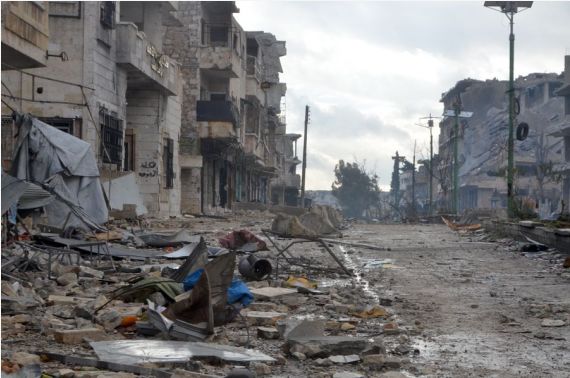The smell of gunpowder is still fresh and the tracks of tanks and armored vehicles are still clear on the muddy road to Maarat al-Numan, the second-largest city in Idlib province, northwestern Syria.
The Syrian army captured the city recently, scoring an important victory against the rebel groups in their last major stronghold in Idlib and clearing part of the way toward securing the entire road connecting the capital Damascus in the south with Aleppo in the north.

However, war is not an easy word, particularly for the ordinary people. Maarat al-Numan, now empty of its residents, has been deserted like a ghost town, silently telling a story of war.
During a tour organized by the Syrian Information Ministry, reporters visited the city with the help of the Syrian army.
Scars of war was vividly seen in the city. The marketplace was empty of shopkeepers and shoppers but crowded with fighters and soldiers, who were breathing the sigh of relief after days of intense battles against the al-Qaida-linked Nusra Front group.
On the walls, warmongering slogans from the rebels are penetrated with bullet holes.
There were houses without walls or ceilings, some buildings were stripped of both walls and roofs and left with staircases exposed to the open air.
Some other buildings were pancaked and seemed to have succumbed to their damage and kneeled down to the ground.
Muhammad Basmeh, a Syrian soldier, jammed his hands in his pocket from the cold wind and said he was happy to be able to take part in liberating the city from the rebel groups. He wished for a quick return of the residents to their homes.
Basmeh himself had tasted the pain of displacement as his family had to flee the battles in the countryside of Latakia province in 2013, saying “losing a home is one of the hardest things the Syrians endured during the crisis.”
In the Sabaa Bahrat, the main square in Maarat al-Numan, a few big palm trees were still standing but the smaller ones were either broken or burnt during the battles. The square’s fountain were dried up.

The famous statue of Abu Al-Alaa Al-Maarri, a historic Arab philosopher, poet and writer, disappeared from the square. The last time that the statue was seen was in a 2013 video by the radical rebels, who beheaded the statue, as al-Maarri was a critic of Islam in his days.
The mosaic painting museum, located near the square, is considered one of the most famous museums in the world as some of the paintings date back to the 5th century.
Some of the paintings were completely destroyed, others were partially damaged while some others were still kept intact, telling the stories of hundreds of years ago.
It is not the only museum damaged during the war, as museums in Aleppo, Palmyra and Idlib were subject to the looting and smuggling of priceless artifacts.
On a radio device, an order was given to the soldiers to gather at the square in Maarat al-Numan with a military officer instructing them to prepare for the next battle that will take place in the city of Saraqeb in Idlib.
“The next target is capturing the city of Saraqeb, which is a key point on the official road linking Damascus with Aleppo,” a military officer told Xinhua.
The officer started explaining to the reporters the battle plan on a map, saying that the Syrian army is advancing from two directions at once, one group is coming from Aleppo and the other from Idlib.
The officer said to the soldiers: “you must be careful and the targeting must be precise to avoid any civilian casualty.”
The officer wished the rebels will quickly surrender in Saraqeb to avert a grinding war in the area.
He repeated the government stance that “the Syrian army will continue to fight until liberating all areas from the terrorist groups.”
On the return of civilians to Maarat al-Numan, the officer said the city needs rehabilitation of its infrastructure, noting that this will start immediately after cleaning the city of mines and war leftovers.
Wafa Shabroni, a reporter working for RT, suffers major injuries in her face while covering the liberation of Maarat al-Numan when rebels’ ammunition exploded while she was nearby.
Shabroni was transferred to the Russian-run Hmeimim airbase in northwestern Syria and later to Moscow to receive treatment.
Maarat al-Numan seems like an example of the Syrian war-hit regions, empty of residents, but left with scars of war and sound of shelling echoing from a distance. Such war has taken its toll on everyone involved.





















